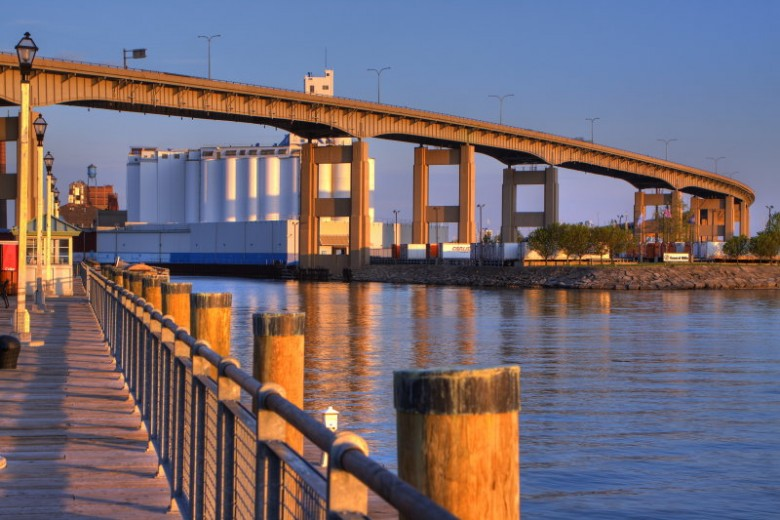Close your eyes. Pretend you are gently rocking on a boat on Lake Erie, not far from the mouth of the Buffalo River. Nice, eh? Now look towards shore. Imagine the Buffalo skyline without the graceful arc of the Skyway.
The Skyway should never have been built. It is a relic of ill-conceived, post-war urban renewal. But it is an iconic feature of Buffalo's skyline. Without it, Buffalo becomes Anywhere, USA.
Its 120-foot span also features the best one-mile stretch of views of the lake, the waterfront, the river, and the city. But the extraordinary cost to maintain it as a highway is unsustainable - and unnecessary. We need to slow down and enjoy those views.
Turning the Skyway into the Skypark, a pedestrian and bicycle-friendly link between the Inner and Outer Harbors, accomplishes all of the goals of tearing it down without any of the downsides. Property values around and underneath it will soar in value, as they have all along the High Line in Manhattan, which has spurred more than $2 billion in new investment in surrounding neighborhoods. And maintenance costs for pedestrian-only traffic would be a tiny fraction of that required were the structure to continue to be used for vehicular traffic. Whatever traffic modifications are devised to ameliorate the impact of demolition would also address the impact of merely eliminating vehicular traffic.
By converting the Skyway into a park with views of the crowds on Canalside, HarborCenter, the rewatered canals, Downtown, the USS Little Rock, the illuminated grain elevators, the graceful curves of the Buffalo River, RiverWorks and Riverfest Park, the Outer Harbor, the Canadian shoreline...we are re-purposing an existing structure to enhance our waterfront rather than detract from it. This is a far more environmentally sound alternative than demolition. Less rubble in landfills (or worse yet, in the lake, where the Father Baker Bridge ended up) and promotes healthy, green alternatives to driving or ferrying.
The Skypark could be as simple as the Walkway Over the Hudson (212 feet above the river and 1.28 miles long) in Poughkeepsie, which was repurposed by merely eliminating vehicular traffic and is now pedestrian-only. Or it could be as fabulous as the High Line on the West side of Manhattan, a 1.5-mile long raised railway bed which has been transformed into a public park that now features pathways, trees, gardens, grasses, seating areas, performance spaces -- and more than 4 million visitors each year. Communities across the nation (as close as Cleveland) and around the world are busy building elevated pedestrian bridges to accomplish what Buffalo has at its finger tips, and at a fraction of the cost.
I propose using the projected $20 million cost of demolition to instead transform the Skyway into a valuable addition to Buffalo’s burgeoning waterfront and high quality of life, a critical link in the Niagara River Greenway, a spectacular tourist attraction and destination, and a catalyst for economic development. Those monies are better spent to:
* Eliminate a number of intrusive and structurally unnecessary downtown on/off ramps.
* Tear down the access ramp from I-190 southbound to the Skyway (2) and from the Skyway to I-190 southbound (2), and the entire Seneca Street loop (1).
* Keep the Elmwood Ave/Church Street access in place, and leave the off ramp onto Pearl Street intact as bicycle/pedestrian direct access points from/to downtown and Canalside and the Outer Harbor.
* Create bike paths, grassy areas and gardens, sunset viewing stations, way signage, historic signage, and other amenities. Install stairs and elevators to provide access at existing points along the structure. Add fencing and/or plexiglass along the perimeter to ensure safety, especially during the winter months when the park could be used for sledding, cross-country skiing and snowshoeing.
The Skypark should become a dramatic and critical link in the Niagara River Greenway, and indeed, Niagara River Greenway Commission support for the repurposing of the Skyway in this manner should be sought for enhancements to this new park.
In addition to providing a pedestrian and bicycle-friendly link between the Inner and Outer Harbors, this re-use of the Skyway will make Canalside two-stories! Concerts and events will be accessible from above, and additional Canalside attractions could be added. How about a bungee jump concession to complement the kayaks and icebikes?
Imagine the Skyway as the Skypark during The Skyride, a spectacular car-free opportunity to ride a bike on the Skyway on Sunday, May 21.
Isn't this the most logical and least expensive option for the Skyway?

